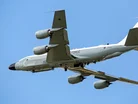MOD regulations to enhance Cyber Security for Airworthiness

Recognising the significance of robust cyber security measures in the aviation industry, the United Kingdom's Ministry of Defence (MoD) has unveiled groundbreaking regulations to fortify airworthiness standards.
The new cybersecurity regulations, implemented by the Military Aviation Authority (MAA), promise to revolutionise the defence against cyber attacks, ensuring the utmost safety and resilience of air systems.
This article delves into the key aspects of the MAA's visionary regulations and their profound impact on the aviation sector.
Enhanced cyber security measures
The MAA's cyber security regulations mark a paradigm shift in airworthiness requirements, addressing the emerging challenges posed by cyber threats.
By focusing on proactive measures, the new guidelines encourage a comprehensive approach to cyber security, promoting resilience, risk management, and continuous improvement.
Air systems and their supporting infrastructure are now required to meet stringent security standards, including vulnerability assessments, threat intelligence integration, secure design principles, and robust incident response protocols.
Collaboration and information sharing
Acknowledging that cyber security is a collective responsibility, the MAA regulations emphasise collaboration and information sharing among stakeholders.
Aviation industry participants, ranging from manufacturers to operators and maintainers, are encouraged to share cyber threat intelligence and best practices.
This collaborative approach fosters a dynamic ecosystem where knowledge is shared, leading to enhanced resilience and the ability to counter evolving cyber threats effectively.
Risk-based approach
The MAA's regulations on cyber security adopt a risk-based approach, recognising the need for tailored security measures that strike a balance between operational efficiency and security requirements.
Through thorough risk assessments, organisations can identify vulnerabilities, allocate appropriate resources, and implement robust controls to effectively mitigate risks.
This approach acknowledges that one size does not fit all, allowing organisations to address their specific needs and enhance their cyber security posture.
Adaptive compliance framework
To keep pace with the rapidly evolving cyber threat landscape, the MAA regulations introduce an adaptive compliance framework.
Rather than static and inflexible guidelines, this framework allows for continuous monitoring, evaluation, and adaptation of cyber security practices.
By staying agile and responsive, organisations can proactively identify and address emerging threats, ensuring the long-term integrity of air systems.
Training and awareness
With a keen recognition of the vital role human factors play in cyber security, the MAA regulations emphasise the significance of training and awareness programs.
Organisations are mandated to deliver comprehensive cyber security training to their personnel, equipping them with the essential knowledge and skills to effectively identify and respond to potential threats.
By nurturing a culture of cyber security awareness, the aviation industry as a whole can fortify its defences against cyber attacks, working collectively to ensure robust protection.
As technology continues to advance, so do the threats it poses.
The MAA's pioneering regulations on cyber security for airworthiness signal a new era of resilience and preparedness in the aviation industry.
By embracing these regulations, stakeholders can bolster their security postures, ensuring the safety and reliability of air systems in the face of ever-evolving cyber threats.
The world is becoming increasingly interconnected, and in line with this the importance of cybersecurity in the aviation sector cannot be overstated. The MAA's regulations serve as a beacon of progress in safeguarding critical infrastructure.

